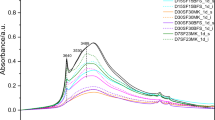Abstract
Thermogravimetric analysis is one of the most common instrumental techniques used for the characterization of pastes, mortars and concretes based on both calcium hydroxide and Portland cement. Important information about pozzolanic materials can be assessed concerning calcium hydroxide consumption and the formation of new hydrated products. Nevertheless, in some cases, problems associated with the overlapped decomposition processes for hydrates make the analysis of obtained data difficult. In this paper, the use of high-resolution thermogravimetric analysis, a powerful technique that allows separating decomposition processes in analysis of hydrated binders, was performed for spent FCC catalyst—Portland cement pastes. These pastes were monitored for 1, 4, 8 h and 1, 2, 3, 7 and 28 curing days. In order to study the influence of the pozzolanic material (spent FCC catalyst), Portland cement replacements of 5, 15 and 30 % by mass were carried out. The presence of spent FCC catalyst in blended pastes modified the amount and the nature of the formed hydrates, mainly ettringite and stratlingite.






Similar content being viewed by others
References
Haines PJ. Thermal Methods of Analysis. London: Blackie Academic Professional; 1995.
Ramachandran VS. Applications of differential thermal analysis in cement chemistry. Revere: Chemical Publishing Company; 1969.
Dweck J, Büchler PM, Coelho ACV, Cartledge FK. Hydration of cement blended with calcium carbonate. Thermochim Acta. 2000;346:10–113.
Bhatty JI. A review of the application of thermal analysis to cement-admixtures systems. Thermochim Acta. 1991;189:313–50.
Frías M, Vigil R, García R, Rodríguez O, Goñi S, Vegas I. Evolution of mineralogical phases produced during the pozzolanic reaction of different metakoalinite by-products: influence of the activation process. Appl Clay Sci. 2012;56:42–52.
Lin YH, Adebajo MO, Frost RL, Kloprogge JT. Thermogravimetric analysis of hydrotalcites based on the takovite formula NixZn6−xAl2(OH)16(CO3)·4H2O. J Therm Anal Calorim. 2005;81:83–9.
Zhu J, Yuan P, He H, Frost RL, Tao Q, Shen W, Bostrom T. In situ synthesis of surfactant/silane-modified hydrotalcites. J Colloid Interface Sci. 2008;319:498–504.
Xi Y, Ding Z, He H, Frost RL. Structure of organoclays-an X-ray diffraction and thermogravimetric analysis study. J Colloid Interface Sci. 2004;277:116–20.
He H, Yang D, Yuan P, Shen W, Frost RL. A novel organoclay with antibacterial activity prepared from montmorillonite and Chlorhexidini Acetas. J Colloid Interface Sci. 2006;297:235–43.
Frost RL, Mills SJ, Erickson KL. Thermal decomposition of peisleyite: a thermogravimetry and hot stage Raman spectroscopic study. Thermochim Acta. 2004;419:109–14.
Yang D, Yuan P, Zhu JX, He HP. Synthesis and characterization of antibacterial compounds using montmorillonite and chlorhexidine acetate. J Therm Anal Calorim. 2007;89:847–52.
Levchik SV, Ivanshkevich OA, Costa L, Gaponik PN, Andreeva TN. Thermal decomposition of tetrazole-containing polymers. IV: poly-1-vinyl-5-methyltetrazole and poly-1-vinyl-5-phenyltetrazole. Polym Degrad Stab. 1994;46:225–34.
Berkovich AJ, Young BR, Levy JH, Schmindt SJ, Ray A. Thermal characterisation of Australian oil shales. J Therm Anal Calorim. 1997;49:737–43.
Borrachero MV, Payá J, Bonilla M, Monzó J. The use of thermogravimetric análisis technique for the characterization of construction materials. J Therm Anal Calorim. 2008;91:503–9.
Payá J, Borrachero MV, Monzó J. The use of MaxRes for the investigation of partially hydration Portland cement systems. User Comput. 2000;11:15–7.
Tobón JI, Payá J, Borrachero MV, Soriano L, Restrepo OJ. Determination of the optimum parameters in the high resolution thermogravimetric analysis (HRTG) for cementitious materials. J Therm Anal Calorim. 2012;107:233–9.
Borrachero MV, Payá J, Bonilla M, Monzó J. Nuevos procedimientos de análisis termogravimétrico para la caracterización de materiales de construcción: aplicación a yesos. Actas del VIII Congreso Nacional de Materiales (Valencia) 2004;89–96.
Tobón JI, Payá J, Borrachero MV, Restrepo OJ. Mineralogical evolution of Porland cement blended with silica nanoparticles and its effect on mechanical strength. Constr Build Mater. 2012;36:736–42.
Payá J, Monzó J, Borrachero MV. Fluid catalytic cracking catalyst residue (FC3R): an excellent mineral by-product for improving early strength development of cement mixtures. Cem Concr Res. 1999;29:1773–9.
Payá J, Monzó J, Borrachero MV, Velázquez S. Cement equivalence factor evaluations for fluid catalytic cracking residue. Cem Concr Compos. 2013;39:12–7.
Su N, Fang HY, Chem ZH, Liu FS. Reuse of waste catalysts from petrochemical industries for cement substitution. Cem Concr Res. 2000;30:1773–8.
de Lomas MG, de Rojas MIS, Frías M. Pozzolanic reaction of a spent fluid catalytic cracking catalyst in FCC-cement mortars. J Therm Anal Calorim. 2007;90:443–7.
Soriano L, Monzó J, Bonilla M, Tashima MM, Payá J, Borrachero MV. Effect of pozzolans on the hydration process of Portland cement cured at low temperatures. Cem Concr Compos. 2013;42:41–8.
Pacewska B, Willińska I, Bulowska M. Calorimetric investigation of the influence of waste aluminosilicate on the hydration of different cements. J Therm Anal Calorim. 2009;97:61–6.
Payá J, Monzó J, Borrachero MV, Velázquez S, Bonilla M. Determination of pozzolanic reaction of fluid catalytic cracking catalyst residue. Thermogravimetric analysis studies on FC3R-lime pastes. Cem Concr Res. 2003;33:1085–91.
Payá J, Monzó J, Borrachero MV, Velázquez S. Evaluation of the pozzolanic activity of fluid catalytic cracking residue (FC3R). Thermogravimetric analysis studies on FC3R- Portland cement pastes. Cem Concr Res. 2003;33:603–9.
Pacewska B, Willińska I, Bukowska M. Hydration of cement slurry in the presence of spent cracking catalyst. J Therm Anal Calorim. 2000;60:71–8.
Pinto CA, Büchler PM, Dweck J. Pozzolanic properties of a residual FCC catalyst during the early stages of cement hydration. Evaluation by thermal analysis. J Therm Anal Calorim. 2007;87:715–20.
Dweck J, Pinto CA, Büchler PM. Study of a brazilian spent catalyst as cement aggregate by thermal and mechanical analysis. J Therm Anal Calorim. 2008;92:121–7.
Willińska I, Pacewska B. Calorimetric and thermal analysis studies on the influence of waste aluminosilicate catalyst on the hydration of fly ash-cement paste. J Therm Anal Calorim. 2014;116:689–97.
Acknowledgements
This work was supported by the Ministry of Science and Technology, Spain (Project MAT 2001-2694).
Author information
Authors and Affiliations
Corresponding author
Rights and permissions
About this article
Cite this article
Soriano, L., Tashima, M.M., Bonilla, M. et al. Use of high-resolution thermogravimetric analysis (HRTG) technique in spent FCC catalyst/Portland cement pastes. J Therm Anal Calorim 120, 1511–1517 (2015). https://doi.org/10.1007/s10973-015-4526-z
Received:
Accepted:
Published:
Issue Date:
DOI: https://doi.org/10.1007/s10973-015-4526-z




